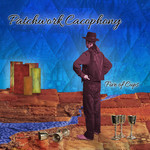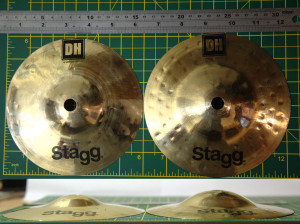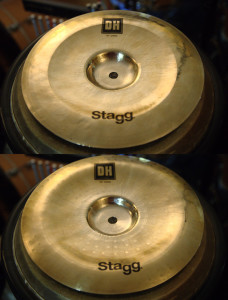Review: Stagg Splash Cymbals
This was originally intended as a review of some Stagg mini-china and splash cymbals, primarily the DH 10″ china and the DH 6″ splash. However, by chance I ended up with a pair of each of these cymbals and to some extent it has now become an article on the variation between cymbals within the same model line.
First up I want to distance myself from a lot of the automatic Stagg-is-cheap-junk views out there. There’s a lot of brand loyalty and get-what-you-pay-for mentality in equipment circles of all sorts, and drummers are no exception. I’m going to cut to the chase here and say that one of the two DH 10″ chinas I bought is fast becoming one of my favourite cymbals, even next to the Sabian AAX, HHX Evolution and Paiste Sound Creation cymbals I’ve got. But in that comment lies the nub of this review: only one of those two supposedly identical chinas is that lovely. The other is completely different and will be going back to the shop.
The Back Story
Let’s rewind a bit. Many years ago I was looking for a cheap china. I read about Neil Peart using a 18″ Wuhan china and happened to see one for sale for a good price with a 12″ china and 10″ splash thrown in for free. They’re all very raw cymbals, but I’ve found them very useful sounds, especially the 12″ Wuhan china. I was interested in what other Wuhan cymbals available, but they turned out not to be available in the UK.
A little after this, I heard (perhaps correctly, perhaps not) that Stagg cymbals were at the time made in the same factory as the Wuhans, and to the same blueprints. A quick visit to a local music store confirmed that the Stagg 12″ china was very similar to the Wuhan, but there was nothing else of interest in stock so I left empty-handed. The Stagg name lodged in my memory though.
Fast-forward to a year or two ago, and Stagg’s profile and cymbal quality had come a long way. I found another local shop that had some stock and tried various cymbals and hi-hats. I felt they were significantly better than all but Sabian, Zildjian and co’s “professional” ranges, but not quite up there with their absolute cream of the crop stuff. They were certainly extremely good value though and I left with an 8″ DH Exo Crash which I still think is a fantastic little cymbal.
What I really wanted though was some cleaner sounding chinas. The Wuhans are great at what they do, but they’re not subtle. Some chinas have a beautiful swishy sound — a fast but smooth “Psshh”. I tried a 16″ DH china but found it needed to be hit too hard, too loud to sound properly. I had started hearing references to their “china splashes” or mini chinas which sounded a lot more interesting though, and so began a year or two of trying to track down and play the Stagg 8″ and 10″ DH and SH range cymbals.
It was a lot harder than anticipated. No-one local had them, and though they’d order them in it would be on payment of deposit and understanding that I’d buy them. So whenever I went to a new city or town, if I had time I’d visit the drum shop. Off the top of my head I can list eight towns I tried, and there’s probably several more. In short, most places didn’t stock Stagg and were very sniffy about them. A few did, but they were small music shops selling no-name kits and the cheapest, most basic “get you started” Stagg cymbal sets. Certainly nothing as exotic as a china. There were a couple of the huge music superstores which often had several models in the shop and plenty more in their catalogue but never seemed to have the chinas in stock on the day I visited.
Eventually I struck it lucky and found a 10″ DH china in a shop while I was away from home. It was gorgeous, and I bought it on the spot. Sadly, they didn’t have the other models I was interested in and though I almost got side-tracked into buying some others I snapped out of it when counting the cost of cymbal stands I’d need for Nice But Not Quite cymbals. The 10″ DH china however sounds lovely on its own, and lovely stacked with a Sabian AAX 10″ Splash. I couldn’t decide which sound I liked more.
In the end I gave in and ordered a selection online. I bought a 10″ SH china to stack with the AAX, an 8″ DH china, an 8″ DH splash and a 6″ DH splash. The idea was to free up my 10″ DH for use on its own, make another stack from two of the others (possibly in combination with something I already had kicking around) and to use the rest as they were.
The 10″ SH turned out to be a mistake. On its own it sounded clangy and, though the DH had been great in a stack, the SH didn’t have the same profile and rather than the slightly more raw sound I’d hope for. It simply buzzed and rang, not making good enough contact with the AAX splash for that sharp, choke and biting sizzle.
The 6″ DH splash was nice on its own but it had a very pronounced profile and wouldn’t stack inside anything else I had. The 8″ DH splash was nothing special, but it was fine as a contrast to the DH 8″ Exo splash so I was OK with that. The 8″ DH china was, however, the biggest disappointment, sounding nothing like its smooth, refined 10″ DH brother and again being clangy and unmusical. And no combination of the new cymbals would stack successfully. Luckily, the shop demonstrated good customer services and I arranged to return the two chinas in exchange for a 10″ DH china and a 6″ DH splash to stack.
And now this is where I begin to realise that cymbal reviews (for some manufacturers or cymbal ranges) are essentially meaningless. The two cymbals that arrived — notionally twins of those I had already — bore no resemblance to the two I already had. I expect some variation of course, but these were radically different. I could review my 8″ DH Exo Splash or one of my 10″ DH Chinas and tell you honestly that I would pay five times as much for them. They are exceptionally good cymbals — right up there with the Vault, Signature or Unicorn’s Teeth ranges from big names.
As it happens, the second 6″ DH is also very nice. It’s very different — about ¼” smaller and with a completely different profile — but it still sounds good and is worth the money. The second 10″ DH china though sounded more like its 8″ brother it was bought to replace: clangy and unmusical. And its profile was radically different and so it wouldn’t stack with anything I had either. After various attempts at finding a use for it, it’s ended up going back for a refund.
The Cymbal Details:
So how different are these cymbals? Well, here are sum numbers and sounds.
The two 6″ DH splashes first. These were the most obviously different on a visible level, but they both sounded good.
1: diameter 150mm; height 19mm, weight 96g; tight, low bell.
2: diameter 156mm; height 24mm, weight 113g; wide, pronounced bell.
The character is similar apart from pitch (with the smaller one higher as you’d imagine). The larger is slightly more stable in character, with the lighter one having a more noticable ringing pitch. The larger one stacks above cymbals well (by virtue of its large bell). The smaller may have sat well inside the 8″ DH china but I no longer have it to check. They were bought within a week of each other from the same supplier.
The two 10″ DH chinas were a lot more similar to look at, with one key difference being the shape and position of the inversion on the bow which marks out a china as a china:
1. 38mm edge to inversion; weight 260g.
2. 27mm edge to bow; weight 240g
The first is high pitched, swishy, mellow and musical. The second is, to my ears, clangy. The first has a pronounced crease at the china inversion point on the bow and the second has a more rounded inversion and a more pronounced lathing pattern. They were bought from different suppliers about a month apart.
Conclusions:
The bottom line is that there are a lot of lovely Stagg cymbals out there, and I will keep trying and buying them, but as individuals that I try on the spot. Not as a “10 inch DH china” but as “that cymbal there, on that stand, that I just played”. The trouble is that as local music stores keep closing (my two local town stores have both closed in the last year) and the pressure to buy online increases, it gets harder and harder to follow the classic advice: take your own cymbals along to a sympathetic local shop, play them in combination with everything they have, buy what sounds good and be prepared to pay a little extra for the privilege.
I should probably state the obvious — that a lot of what makes a cymbal sound “good” or “bad” is subjective, and more so it’s about context. As much as I berated some of the cymbals for being clangy, the Wuhan 12″ china which is a permanent fixture on my kit is the king of clang. But its sound is useful to me whereas the Staggs I rejected were neither one nor the other. In particular, I’m looking for cymbals for studio use. That means cymbals which sound good when you listen closely but don’t necessarily have to do the live cymbal job of cutting through a wall of guitar noise. In fact, I favour quiet cymbals because it’s easier to mic one up than turn it down.
In the end, the message from this review is not that Staggs are good or bad. Some of them are sublime, some aren’t to my taste. The message is that part of what you get for the fact that they are considerably cheaper is not as simple as good or bad, it’s that they are inconsistent. Try them before you buy, and buy the exact one you try, but do try them if you can, because the good ones can be gems.
Tags: cymbals, stagg|Flattr this!


